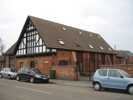For this church:    |
|
| To the greater glory of God, in the faith of Jesus Christ, to the further work of His Church, this comer stone of an Infant School and Mission Room attached to the Parish Church of St. Mary Magdalene, Newark upon Trent, was laid by William Newzam Nicholson Esq. J. P. on Tuesday, the sixteenth day of March in the year of Our Lord One Thousand Eight Hundred and Eighty Six. Marshall Wild M. A. Oxon. Vicar. George Ward Saunders B. A. Cantab. Edward Bate B. A. Cantab. Assistant Curates William Newton William Mather John Thomas Wilkinson William Kelly, Church Wardens Becher Tidd Pratt Esq. Mayor George Sheppard, Architect Frederick William Crossland, Builder |
The consecration ceremony was performed four months later on 22 July. A special thanksgiving service was held and a celebratory tea for over 400 people laid on at the Town Hall.
In September 1886 it was decided to name the Mission Room after St Augustine and it quickly established regular morning and evening services throughout the week.
By 1912, some enlargements had been made and the church could accommodate 200 sittings. In this year, there were 327 children on the roll for the Sunday School.
A new reredos of dark wood was dedicated in April 1915.
In 1929 the Arts and Crafts Society of Nottingham gifted a new white altar frontal.
The choir of St Augustine’s was remembered favourably as a source of local pride. William Becher Tidd Pratt acted as choirmaster from 1906 to 1956. The choir were sometimes known as the ‘Tidd Pratts’ Angels’. Entrance was strictly on merit and Pratt conducted auditions amongst the boys at local schools.
Plans to close the church were first put forward in 1993 in response to dwindling attendance numbers. The church closed in 1998 and was converted into housing.
Miss Gwen White, Sunday school teacher and churchwarden from 1976-1985, recalled that the church ‘has meant everything to me and my family throughout our lives’.
Another longstanding member, Miss Rhona Parsons, aged 85 in 1998, told the Newark Advertiser that she had started at the Sunday school when she was 5 years old: ‘St Augustine’s became my whole life… I have loved St Augustine’s and am very sad to see it close’.






